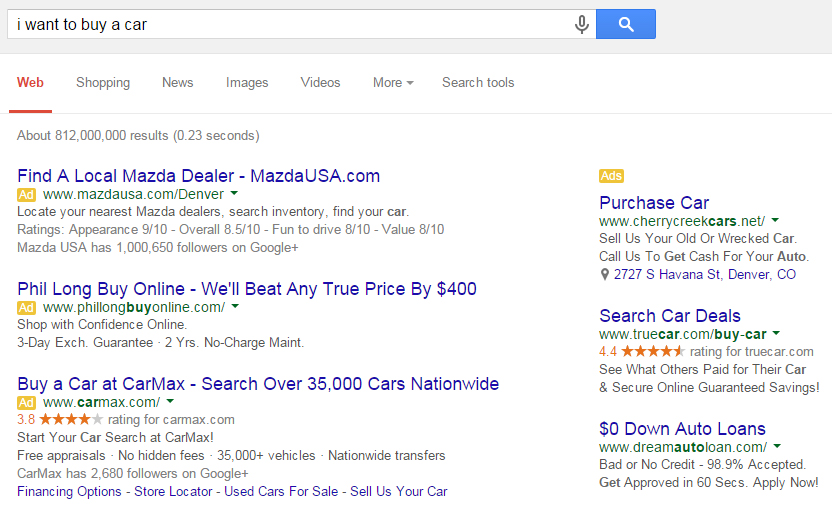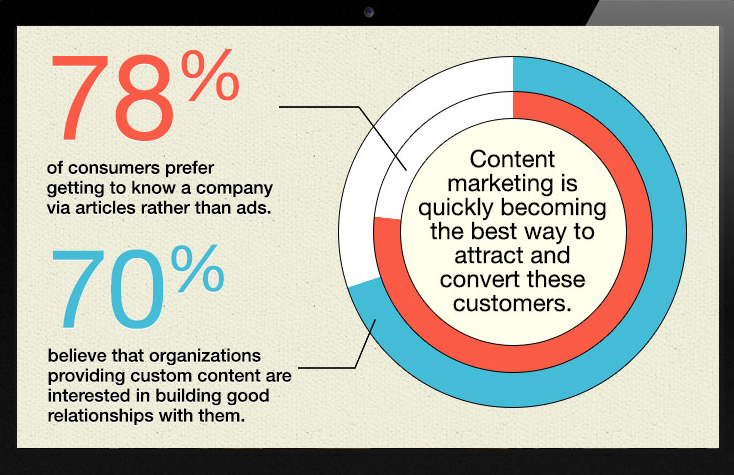
Remember those times when you actually had to visit a store in order to buy something? Those times seem like distant past as many have been discovering the convenience of online shopping. You sit comfortably at home, you don’t have to wait in front of the cloakrooms, there are no tedious lines and crowds and you can switch or return anything you don’t like – sounds like a dream. And it has become a reality for many shoppers.
Online shopping or eCommerce is fully integrated into our lives and right now it is hard to imagine our life without it. If you’re looking to expand your business with a webshop or open up a completely new online business – you’ve come to the right place. We’ll walk you though all the steps you’ll need to understand fully how to organize and reap the benefits of an online business.
Let’s start!
What Is Ecommerce?
Ecommerce, also known as electronic, online or internet commerce is a business model that refers to buying and selling the products or services using the Internet. Simply, it is a way of doing business over the internet without having to visit the physical store. The most popular example of eCommerce is online shopping, but there are also other types of activities such as payment gateways, online auctions, online ticketing, and internet banking. There is even a precaution for safe use. In this case, you need a VPN option for Android users, ios, Mac, or Windows.
Also, when thinking about the past of eCommerce, it has definitely evolved through the years. Examples are seen in improved payment options, faster shipping, more developed UIs, automatic order processing, and more. These changes had a significant impact on customer understanding of the usefulness of eCommerce.
Planning an E-Commerce Business
When thinking about your business idea, first and foremost, you need to figure out what you do best. The questions you could ask yourself are:
What am I selling?
Who do I want to sell it to?
How am I sourcing my product?
Once you have selected a product to sell, make your brand the most attractive option for your target audience. To be sure that the existing targets are reachable and clear, each one should be set focusing on SMART goals. They are easy to use by anyone, anywhere, without the need for specialist tools or training.
Make your goal SMART, following these criteria:
- Specific (simple, sensible, significant)
- Measurable (meaningful, motivating)
- Achievable (agreed, attainable)
- Relevant (reasonable, realistic and resourced, results-based)
- Time-bound (time-based, time-limited, time/cost limited, timely, time-sensitive)
Want to find out what is the actual cost of building an eCommerce website? Read the article!
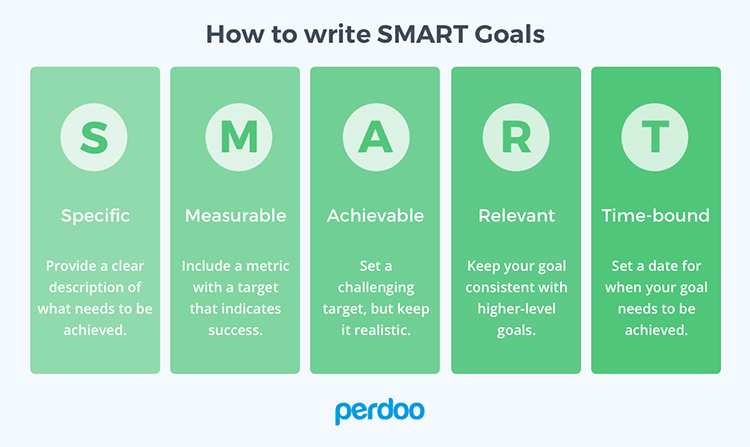
Picture 1. SMART goals
However, planning an e-commerce business, without constructing a business plan can be tempting. Therefore, putting your ideas down on paper can help you set clear goals for your business from the outset. What you should hope to get out of a business plan is market and business knowledge.
In other words, a better sense of what you know and more importantly, what you don’t know. You should also get a better overview of the resources you’ll need to make your online business successful, such as partners, money, and employees. After finishing your business plan, you should have a better sense of the viability of the opportunity.
How to Start an Ecommerce Business?
If you’re starting an e-commerce business from scratch, it’s time to start ticking off things from your checklist, so here it is.
Step 1: Choose your e-commerce niche
Choosing a niche is the most important step in starting an online business. It’s suggested to start this process by identifying successful companies already working in this sphere. Thus, nor the most competitive or the least competitive market area is a good choice.
„If having issues with this part, narrow it down and make your niche more specific.“
When narrowing it to micro-niche marketing, you can rank your content for related keywords more easily. The benefit is also having a lot of “shoulder” niches with whom business owners can work together in order to grow the customer base.
Step 2: Research business models
The goal is to find a type of commercial model that works best for your business. A business model refers to a plan for successful business growth, and how it relates to current products or services in the industry. Here are the 4 main types of e-commerce models. They describe almost every transaction that takes place between consumers and online businesses.
Business to Business (B2B): This model is the one where the exchange of goods or services takes place between companies instead of individuals. It is usually a situation whereby one company provides goods or services online with other companies as its target audience.
Business to Consumer (B2C): This model refers to the distribution of goods and services from business to individual consumers. Examples of this model are Amazon and PayPal.
Consumer to Business (C2B): Opposite from the B2C model, this one is when a consumer sells their products or services to a business or organization. Examples can be programmers, social media managers, content creators, and other services providers working online.
Consumer to Consumer (C2C): When a consumer sells a product or service to another consumer, usually through a third-party website. Example from Magneto: „Cryptocurrency exchanges that offer over-the-counter trades to users. Under such circumstances, the exchange charges a fee for the transaction while it allows the users to transact cryptocurrencies with one another.“
Step 3: Buyer personas and product selection
Sometimes, before developing the idea of your business, is even better to think about the buyer personas of your brand. Who are you? Who are your customers? What does your business represent?
„The persona of your brand has to match the expectations of your customers and the products you choose to carry.“
You need to project a consistent brand image because your goal is to gain a lot of targeted traffic in your business. To expect people to buy your product, you have to know who you’re selling to. In this case, surveys are a quality source. Through surveys, you’ll get a better insight into the factors that keep your customers buying again and again. That way you can find people who are genuinely interested in your brand.
Still haven’t created your buyer personas? Do it with the help of our guide!

Picture 2. Use surveys to see why customers use your products
Step 4: Establish your brand and business
Once you’ve identified the image you want to project and target group for your eCommerce business, it’s time to start with product ideas. Whatever you go for, remember that often less is more. Before you invest in the product, evaluate it carefully. Almost anything on your website that harms visitor behavior can be A/B tested. Also, start thinking about your product price and what customer problems they solve. That will give you a better idea of how to set your pricing model correctly. If you set a price too low, you could fail with your return of investment. On the other hand, if your price is too high, ti’s highly likely that a lot of your customers won’t be able to afford it.
Step 5: Create your online store
When choosing an eCommerce store builder, consider price, features, support, ease of use and performance. In this phase, you will need to start thinking about the design, registration of your domain name and any redirect URLs that might be relevant. However, it doesn’t mean you will have to hire a development company. It would be enough to use a theme. In that case, depending on your business brand, you might only need to pay a small fee to get a good template.
Once you have created your online store start thinking about the different channels where your audience is most present. Create an omnichannel customer experience strategy to establish better brand visibility and better shopping experience!
Step 6: Attract customers to your eCommerce store
The best eCommerce sites invest a lot in online marketing. If you don’t have funds, there are many other ways to increase publicity. This is individual, though, and depends on whether you will use sponsored content, social media, pay-per-click ads, or combination of them all. Once you decide, keep monitoring what campaigns are driving traffic to your store. However, consider hiring help if marketing your site seems overwhelming.
Read: 8 Ecommerce Marketing Strategies – Stand out from the Competition

Picture 3. To attract customers is to lead them to buy your products
Step 7: Marketing your products online
Track the flow of the traffic on your site. You can use analytics tools to help you monitor and optimize every step of the sales process.
If you notice sales curve is not increasing, although you’re driving traffic to your store, take a close look at your product listings and carefully improve each page. There are thousands of marketing metrics for tracking your e-commerce business success, but only a few of them, directly represent the state of your business and can be turned into actionable insights that help you grow.
These are the eight most important metrics we believe every eCommerce store owner should track:
- Sales Conversion Rate
- Email opt-ins
- Customer lifetime value
- Customer acquisition cost
- Revenue by traffic source
- Average order value
- Shopping cart abandonment rate
- Net Promoter Score
5 Benefits of Ecommerce
It is a well-known reason why e-commerce became so important and had tremendous growth for the past decade. With internet growth, businesses are learning how to take advantage of it. Here is the list of the eCommerce benefits:
Global market
With the expansion of digital, the companies are no longer focused only on local physical stores. Their reach no longer depends on the number of brick and mortar locations they open. Ecommerce makes it easier for companies to expand their reach to more customers using the eCommerce websites. From the local store to the global market is one of the most crucial benefits of eCommerce.
Faster buying
There’s one thing that everybody likes about eCommerce – your customers save a lot of time. And by a lot, we mean really a lot. They don’t have to walk from store to store and wait in lines to try something out. Also – when they’re shopping online, they can order stuff which are maybe not available or are out of stock in their closest store.
They can search through tonnes of products, compare their features and decide easily, all from the comfort of their home. And they get everything delivered to your address. Now isn’t that something that will make your customers very happy?
Targeting customers
Accessing customer data such as habits, interests, gender, status, and other personal information enables companies to stay agile and in shape with marketing activities. Moreover, these types of information help companies provide better customer service. Just having the possibility to address hundreds or thousands of your customers by their name is something.
Working from anywhere
With eCommerce, people can work remotely and don’t have to be in the office from 9 to 5. Having that in mind, all you need is a laptop, excellent internet service and phone to manage your business from anywhere in the world. Also, don’t forget to communicate with your customers online with live chat to boost customer experience and support. Also, when talking about remote work as an increasingly popular practice, you may want to read the article: Remote Work Tips & Tricks.
Reduced costs
Online business benefits significantly from lower running costs. There is no need for a physical storefront or salesperson or even storage (depending on your industry). As a business, you can save on operational expenses so that you can offer better deals and discounts to customers.
What Is Ecommerce Customer Service?
At its core, customer service is the support companies are offering to their customers before, during and after the products or services have been bought. Limit it to eCommerce customer service, which is best described as offering online store help to customers.
In a fiercely competitive world, in order to distinguish themselves from the rest of the market, eCommerce company owners invest in customer experience and customer service strategy. Customer service strategies for eCommerce often require omnichannel customer support, live chat, and purchasing experience that is personalized. These companies’ ultimate objective is to provide eCommerce customer service that will provide them with loyal customers, greater conversion rates and greater customer lifetime value.
Read more about eCommerce customer service and its best practices in our other article: Ecommerce Customer Service: 5 Tips to Stand Out of The Crowd.
What Is Ecommerce Marketing?
Ecommerce marketing promotes your shop through a multitude of marketing channels to prospective customers. It assists you to drive traffic to your online store, which is why we can also describe it as a larger Internet marketing strategy. And that marketing strategy can assist create awareness of the brand, drive customer loyalty, and eventually boost online revenues. So if you want to drive traffic to your online store, implementing ecommerce marketing strategies is crucial.
For example, organic traffic is bread & butter for any e-commerce store looking to survive in the long-run but…Publishing content isn’t enough these days because there is just so much noise out there. You also need to promote it! This is when a link building service can help you grow the store and diversify from social and PPC campaigns. If you want to read more about those strategies, check our other article about it: 8 Ecommerce Marketing Strategies – Stand out from the Competition.
What Is Ecommerce Live Chat?
To keep up with the constant changes that are happening all over the world, and to stand out from the crowd, companies are considering live chat more and more. Not only it can help to improve customer experience, but also increase sales and boost your brands’ credibility. One of the eCommerce challenges is that your visitors are unable to connect with someone who can answer their questions at the same moment. And many researches proved that customer mostly return to those companies who have implemented live chat into their website. That’s why live chat is crucial for eCommerce.
If you want to read more about why eCommerce live chat Is important for your business, check our other article about it: eCommerce Live Chat: Chat more To Earn More.
6 Great Examples of Ecommerce Platforms
An eCommerce platform is a piece of software that allows businesses to create online stores. It also gives you the tools to create and manage your site. Most of the eCommerce platforms provide a one shop stop for business owners to manage an online store with ease. When choosing an eCommerce platform for your business, you should consider a few things. Such as features, price, the technology used, and others. Here are a few great examples:
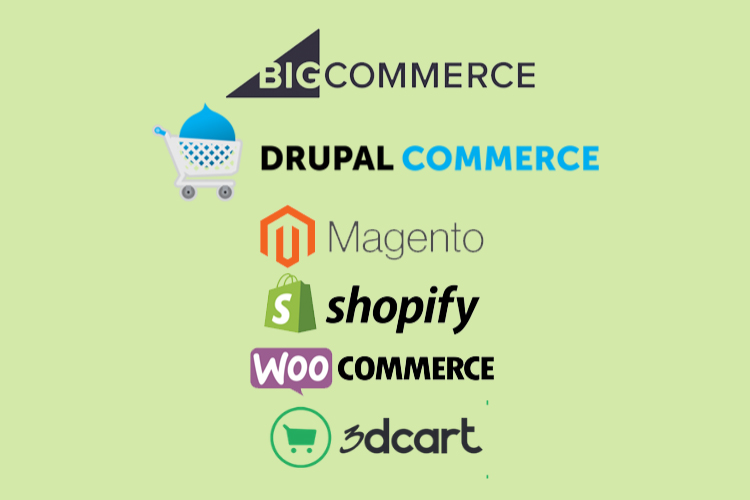
Picture 4. Ecommerce platforms
BigCommerce
This leading ecommerce platform offers features such as a shipping option, site builder, reporting, and more. It also enables retailers to sell on other sites and platforms, including Amazon, eBay, Facebook, Google Shopping and Square. Also, it offers a bunch of good things such as great support, customer loyalty, mobile integration, user-friendliness, and many more things.
Drupal Commerce
An open-source eCommerce framework that allows users to build online applications and stores on Drupal. It is exceptionally adaptable while it offers a lot of modules that allow users to improve and increase its functionalities.
If you want to read more about Drupal, check our blog post: Why users love Drupal.
Also, Paldesk – Live Chat & Help Desk for Drupal allows you to add live chat to your Drupal website quickly and easily. Help your visitors in real-time and convert them into customers! Increase your conversion rates, improve your loyalty and provide brighter interactions directly with your visitors when they’re ready to do so.

Picture 5. Paldesk and Drupal integration
Magento
This advanced eCommerce platform offers powerful features for your online business. It gives merchants the ability to customize their eCommerce store, and you have complete freedom over the look and feel, and functionalities of your site. Plus, it is free and it is built on open source technology. Also, it offers search engine optimization, powerful marketing, and catalog-management tools.
Set up Magento Live Chatwith Paldesk.
Shopify
An eCommerce platform with features that let you sell online, on social media, and in-person. It enables you to build and customizes website through an easy interface as it also enables you to start and grow a business. Plus, they have social selling functionalities for those who are active on Facebook or Pinterest.
Read Ecommerce Platforms to Build Your Business: 8 Popular in 2021.
WooCommerce
WooCommerce is an open-source eCommerce platform for WordPress users. Some of the features include shipping options, reporting, and mobile-friendly functionalities. Even though it is built for WordPress, it also connects with other platforms.
Also, since WordPress is one of the most used platforms on the Internet, you will want to read our other blog post about it: 10 Best WordPress Plugins for Excellent User Experience.
3dcart
This top-tier eCommerce platform is designed to give users everything they need to build and run their own online store. The software includes dozens of built-in features, including essentials and more advanced solutions, and offers a high degree of customization for just about every aspect of the site. Other perks include 24/7/265 customer service, special 3dcart plans for dropshipping and B2B businesses, and more payment processors than any other platform.
Top 6 Ecommerce Tools
It is very important to find the tools that will help you manage your business activities. So here are a few tools to help you reach your full potential:

Picture 6. Ecommerce tools
Asana
Asana is one of the most popular management tools that allow you to create different tasks for each team member, create plans, mark projects and task as completed, and other possibilities. It is flexible and very useful, especially when you have deadlines.
Shopify
It is one of the fastest-growing platforms currently since it is extremely beginner-friendly. This is the right platform for you if you you’re not very proficient in tech and don’t have any resources to hire a professional. It enables you to create a website and use their solutions to sell, ship and manage your products. It is flexible and scalable and offers reliable support to help you along the way.
Search spring
If you want to collect better search data, optimize auto-complete, drive search conversions or provide relevant search results, use Search Spring. One of the largest ecommerce brands that used Search Spring is Stanley Black & Decker. Mostly for their advanced website search and category navigation.
SEMRush
SEMRush is a tool that will let you see your page performance and you will have an insight into competitor site where you can then compare sites. This tool tracks more than 106 million keywords and tracking more than 87 million domains. Also, it offers solutions for social media, PPC, content, SEO and competitive research.
Squarespace
A simple website builder for all types of businesses that offers several options. It is ideal for creating professional websites as it offers the high quality of the templates. One of the best thing about Squarespace websites are the cool features and the fact that is is mobile friendly.
VWO – Visual Website Optimizer
VWO is A/B testing tool that offers a bunch of features that go well beyond just analytics. It is a great tool for marketing professionals as it allows them to create a different version of their websites. Also, it integrates well with most major e-commerce platforms.
If you want to discover more tools so you could easier decide which one suits your business the best, check our blog post: 20+ Best Ecommerce Tools for Emerging Startups.
Top 3 Ecommerce Trends in 2021
Personalization
Ecommerce personalization has become a huge trend among businesses over the past couple of years, but especially in 2020. Since customers expectation of personalization increases, personalization should and will become an eCommerce standard. So, the key to customer satisfaction is personalizing the online shopping experience. By offering a personalized customer experience, you will both deliver a great shopping experience and connect with your customers more.
Rise of Voice Commerce
Voice commerce is one of the newest trends in the eCommerce world. The term is used to describe any transaction with a business that happens when using a voice device. This trend got its popularity way back in 2014 when Amazon launched its smart speaker called Echo. And now it’s on the rise. Research says that by 2022, voice commerce will generate a total of $40 billion in sales.
Mobile Shopping is Growing
Mobile shopping is notably growing. Researches proved that since 2016, sales made via mobile devices increased by 15%. So now would be the best time to optimize and improve your site for mobile shoppers. By improving the ecommerce experience for mobile customers you will open a whole new door with a lot of opportunities. Especially because trust in online shopping is increasing, and consumers feel more comfortable shopping on mobile devices than before. Also, statistics from Statista said that by the end of 2021, 73% of ecommerce sales will take place on a mobile device. So you can see that mobile ecommerce is highly important to retailers who decide to provide online stores.
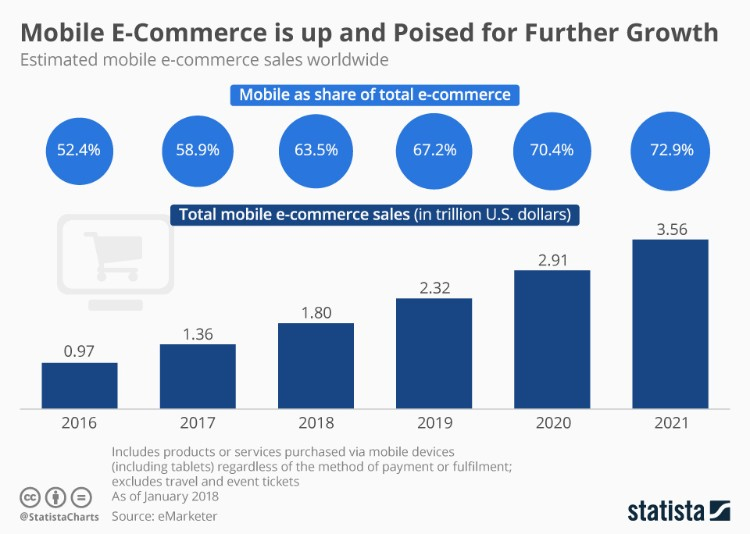
Picture 8. Mobile eCommerce statistics
These are just the 3 main trends but there are a lot more. We wrote about them in our other article that you can read over here!
Also, OptinMonster compiled a list of the most interesting stats for the ‘online shopping’ market in 2020′, so check them out: Online Shopping Statistics for 2021
E-commerce Wrap-Up
After all this information, you are probably asking yourself: “Should I start an ecommerce business?” Well, I guess the answer is clear. Most definitely! It does take careful planning to get your e-commerce business from zero phases to the launch phase, but once you start selling, you can build a successful e-commerce business. Moreover, you can follow the steps pointed out here to cement your own understanding of the market and your business. Do not hesitate to take advantage of lucrative opportunities. To summarize, we hope this guide will help you to develop your own ecommerce business as much as to understand the concept of ecommerce.
Source: https://www.paldesk.com/ecommerce-guide-introduction-how-to-start-an-ecommerce-business/









